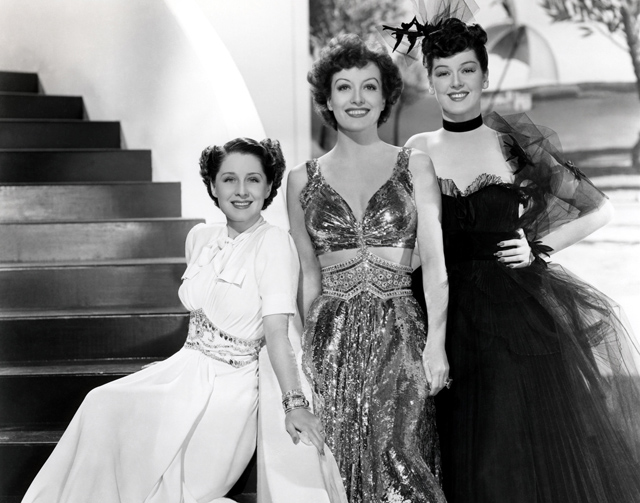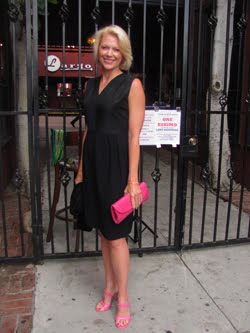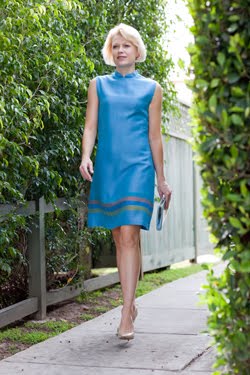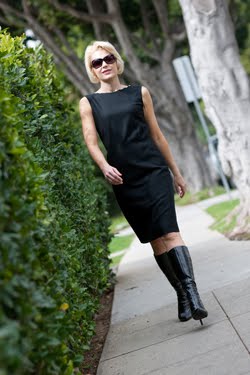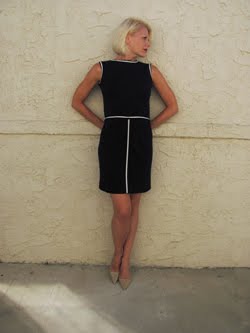Sizes of Old Hollywood
Whenever I do presentations on the History of Fashion in Film, some of the most fascinating facts to audiences are the sizes of their favorite classic cinema stars. As a result, I put together a chart with many of the actresses we know and love. You'll see that this particular list is organized from shortest to tallest, and it also includes their approximate weight and measurements. These measurements are generally the ones recorded at the peak of their popularity. Sometimes they come from the costume designers themselves, such as Adrian. Some come from the studios' press agents for the movie magazines (often idealized for the public, though close to accurate). Some are simply the best guesses of film historians. And some information I simply haven't found yet.
In any case, this list can bring an even greater appreciation for these goddesses. Many of whom seem like giants onscreen; Joan Crawford is one who regularly elicits gasps from audiences when they hear how petite she really was. The illusion was due to the talented production teams--from set designers to clever directors and cinematographers. They of course also included my beloved costume designers, who fixed many a figure flaw in order to turn these actresses into icons.
| Height | Name | Weight | Bust | Waist | Hips |
|---|---|---|---|---|---|
| 4' 11" | Judy Garland | 98 - 155 | 33 | 22 | 34 |
| 4' 11" | Veronica Lake | 98 | 34 | 21 | 33 |
| 4' 11" - 5' 2" | Gloria Swanson | ||||
| 5' | Janet Gaynor | 98 | 31.5 | 23 | 33 |
| 5' | Mary Pickford | 33 | 25 | 36 | |
| 5' | Jane Powell | 108 | 33 | 23 | 33 |
| 5' - 5' 4" | Joan Crawford | 112 | 37 | 24.5 | 37 |
| 5' 1" | Mae West | 121 | 38 | 24 | 38 |
| 5' 1" - 5' 3" | Norma Shearer | 118 | 34 | 25.5 | 37 |
| 5' 1.5" | Jean Harlow | 109 | 34B | 25 | 36 |
| 5' 2" | Miriam Hopkins | ||||
| 5' 2" | Debbie Reynolds | 109 | 36 | 23 | 37 |
| 5' 2" | Shirley Temple | ||||
| 5' 2" | Natalie Wood | 120 | 32B | 22 | 33 |
| 5' 2" - 5' 4" | Olivia de Havilland | 108 | 37 | 23 | 36 |
| 5' 2" - 5 '5" | Louise Brooks | ||||
| 5' 2" - 5' 5.5" | Carole Lombard | 120 | 34 | 24 | 34 |
| 5' 2" - 5' 4" | Elizabeth Taylor | 120 | 32D | 21 | 36 |
| 5' 3" | Jean Arthur | ||||
| 5' 3" | Clara Bow | 112 | 33 | 24 | 36.5 |
| 5' 3" | Leslie Caron | ||||
| 5' 3" | Bette Davis | 34C | 21 | 34 | |
| 5' 3" | Vivien Leigh | 32A | 23 | 33 | |
| 5' 3" - 5' 4" | Tippi Hedren | 110 | 34C | 24 | 32 |
| 5' 3.5" | Lana Turner | 110 | 34 | 24 | 34 |
| 5' 4" | Ann-Margret | 119 | 35 | 23 | 35 |
| 5' 4" | Constance Bennett | 100 | 33 | 26 | 35.5 |
| 5' 4" | Ann Blyth | ||||
| 5' 4" | Bebe Daniels | 120 | 36 | 27 | 37 |
| 5' 4" | Marion Davies | 118 | 35 | 27 | 35.5 |
| 5' 4" | Betty Grable | 126.5-134 | 36 | 24 | 35 |
| 5' 4" | Barbara Stanwyck | 108 | 33.5 | 23 | 33.5 |
| 5' 4.5" | Claudette Colbert | 110 | 32B | 18 - 25 | 34 |
| 5' 4.5" | Marlene Dietrich | 130 | 36 | 26 | 33 |
| 5' 4.5" | Dolores del Rio | 120 | 33 | 25 | 36 |
| 5' 4.5" | Ginger Rogers | 34 | 24 | 35 | |
| 5' 5" | Joan Bennett | 108 | 33 | 25 | 34 |
| 5' 5" - 5' 5.5" | Marilyn Monroe | 115-150 | 36C | 23 | 36 |
| 5' 5" - 5' 7" | Jane Russell | 122 | 38D | 24 | 36 |
| 5' 6" | Cyd Charisse | 34.5B | 22 | 37 | |
| 5' 6" | Catherine Deneuve | 135 | 34D | 24 | 35 |
| 5' 6" | Ava Gardner | 120 | 36 | 23 | 37 |
| 5' 6" | Rita Hayworth | 117 | 36C | 24 | 36 |
| 5' 6" | Hedy Lamarr | 118 | 35.5 | 25 | 34.5 |
| 5' 6" | Myrna Loy | 35.5 | 26.5 | 33.5 | |
| 5' 6" | Kim Novak | 121 | 36C | 25 | 37 |
| 5' 6" | Raquel Welch | 118 | 37 | 22.5 | 35.5 |
| 5' 6" - 5' 7" | Loretta Young | ||||
| 5' 6.5" | Greta Garbo | 125 | 36 | 28 | 38 |
| 5' 6.5" | Rosalind Russell | 120 | 34.5 | 25.5 | 36 |
| 5' 7" | Brigitte Bardot | 125 | 36B | 20 | 35 |
| 5' 7" | Doris Day | 36B | 25 | 36 | |
| 5' 7" | Faye Dunaway | 34 | 25 | 34 | |
| 5' 7" | Anita Ekberg | 40 | 24 | 36 | |
| 5' 7" | Audrey Hepburn | 103 | 34A | 20 | 34 |
| 5' 7" | Grace Kelly | 118 | 34A | 24 | 35 |
| 5' 7" - 5' 8.5" | Esther Williams | 38 | 27 | 34 | |
| 5' 7" - 5' 9" | Kay Francis | 118 | 33 | 25.5 | 35 |
| 5' 7.5" | Katharine Hepburn | 125 | 34B | 22 | 33 |
| 5' 8" | Lauren Bacall | 130 | 34C | 26 | 34 |
| 5' 8" | Sophia Loren | 140 | 38C | 24 | 38 |
| 5' 8" | Ali MacGraw | ||||
| 5' 9" | Ingrid Bergman | 135 | 34 | 24 | 34 |
| 5' 9" | Alexis Smith | 128 | 34 | 24 | 36 |
Feel free to contact me if you can help fill in any of the gaps. I will update the list from time to time for everyone's ongoing reference. If you're interested in the ever-changing ideals of BMI (Body Mass Index) from decade to decade, you can learn more in this interesting article on ThinkDifferently.com.
Since people have expressed interest in the sizes of men of classic cinema, I have put together a chart with their heights as well.
| Height | Name |
|---|---|
| 5' 2"- 5' 4" | Mickey Rooney |
| 5' 4" - 5' 6" | Alan Ladd |
| 5' 6" | Dustin Hoffman |
| 5' 7" | Bing Crosby |
| 5' 7" | John Garfield |
| 5' 7" | Gene Kelly |
| 5' 7" | Al Pacino |
| 5' 8" | James Dean |
| 5' 8" | David Hemmings |
| 5' 8" | Frank Sinatra |
| 5' 8" - 5' 9" | Humphrey Bogart |
| 5' 9" | Fred Astaire |
| 5' 9" | Kirk Douglas |
| 5' 9" | Marcello Mastroianni |
| 5' 9" - 5' 10" | Marlon Brando |
| 5' 10" | Montgomery Clift |
| 5' 10" | Robert DeNiro |
| 5' 10" | Steve McQueen |
| 5' 10" | Paul Newman |
| 5' 10" | Robert Redford |
| 5' 10" | Spencer Tracy |
| 5' 11" | Glenn Ford |
| 5' 11" | William Holden |
| 5' 11" - 6' | William Powell |
| 6' | Van Heflin |
| 6' | Dick Powell |
| 6' | Tyrone Power |
| 6' | Robert Taylor |
| 6' | Franchot Tone |
| 6' 1" | Melvyn Douglas |
| 6' 1" | Clark Gable |
| 6' 1" | Robert Mitchum |
| 6' 1" | Robert Montgomery |
| 6' 2" | Sean Connery |
| 6' 2" | Errol Flynn |
| 6' 2" | Henry Fonda |
| 6' 2" | James Garner |
| 6' 2" | Cary Grant |
| 6' 2" | Burt Lancaster |
| 6' 2" | Joel McCrae |
| 6' 2" - 6' 4" | Gary Cooper |
| 6' 3" | Fred MacMurray |
| 6' 3" | Gregory Peck |
| 6' 3" | Randolph Scott |
| 6' 3" | James Stewart |
| 6' 4" | Clint Eastwood |
| 6' 4" | John Wayne |
Vintage Sizing
Much is made about the fact that Marilyn Monroe was reportedly a size 10. Grace Kelly was, too. But it is important to know that this refers to a vintage size 10. Clothing sizing and silhouettes have both completely changed in the past 70 years, and this often causes a lot of confusion. In order to help your experience with any of your vintage shopping ventures, the following can give you a little understanding about the evolution of fashion over that time.
Let’s first discuss sizing. Once and for all—and ladies, I want you to hear me loud and clear—the sizes attached to clothing are essentially meaningless. There is zero consistency in sizing from year to year. None. I have examined sizing charts for dress patterns from the late 50s all the way through the early 70s, and each year the allowed measurements (for bust, waist, hips, e.g.) have increased. So the sad truth of the matter is that clothing manufacturers have understood our vanity well, and simply made our clothes bigger and bigger while making the sizing on the labels smaller.
Though inconsistent, I can give you at least a general understanding of vintage sizing. A rule of thumb is to double your current numerical dress size and you will have your vintage size. This is close, but still only approximate.
Size 2 today is about a vintage size 8
Size 4 today is about a vintage size 10
Size 6 today is about a vintage size 12
Size 8 today is about a vintage size 16
Size 10 today is about a vintage size 18
Again, sizing charts have rarely stayed the same even from one year to the next. Further, sizing between design houses is also often very different. That remains true today. So the moral of the story is to ignore the size on the label and know your own measurements. Here are guidelines for taking the basics:
Bust Measure under your arms, around the fullest part of your chest.
Waist Measure around your natural waistline, the narrowest part of your body, keeping tape a bit loose.
Hips Measure around the fullest part of your body at the top of your legs, usually anywhere from 6 to 9 inches below your waist. This video helps you find the right spot.
In any vintage listing, you should be able to learn the measurements of the garment—bust, waist, and hips. Other measurements may also be included, such as skirt length (waist to hem) and sleeve length for the coats. My recommendation is to find garments that will fit you in what you know to be your most difficult to fit area. For many, it’s the bust. My own guide is the usually the waist measurement.
You should never buy any clothes—new or vintage—that are too small for you. They are frequently bought as “incentive” to lose weight, when what they really become is a morale killer and a beautiful dress that just sits in your closet. Better to buy a dress that’s one or even two sizes too big. You should be going to a tailor anyhow, so it really doesn’t matter. Think of it as molding that dress to your body.
Vintage Silhouettes
Vintage Silhouettes
Silhouettes—the shape of a garment—have also changed through the years along with the sizing. Part of the reason for this is that there are significant differences between how we wear clothes now and the way our mothers and grandmothers wore them. The impact of undergarments alone. Dresses from the early 1950s, for instance, expected there to be a girdle between the woman and the fabric. They were fitted for those cumbersome foundation garments to be worn every minute of every day. It shaped a woman in a very certain and constrained way. Very beautiful. Very exaggerated. It affected the way we moved.
Then comfort started to become more important. Career clothes were improved as more and more women began flooding the workforce. Eventually we even mixed comfort in formal gowns...Halston in the 1970s is a great example. You can see the design arc move gradually from very voluptuous to more streamlined silhouettes. By the late 60s and early 70s, silhouettes stood away from the body rather than hugging it, bustlines were reduced, and shoulders and sleeves narrowed as well.
Each decade designed for its ideal body shape, so you can actually use that to steer your shopping in vintage clothing.
Hourglass The 1950s are your decade. Nearly anything works on beautiful hourglass figures, from dresses with those cinched waists and flared skirts (see above) to hip-hugging pencil skirts.
Pear Sheath and A-line dresses of the late 1950s and early 1960s are very flattering on this body type. Also 1950s dresses with those full swinging skirts are wonderfully forgiving of the hips.
Apple The late 1960s and early 1970s offer shift dresses that are perfect for this body type. You want shapes that don’t over emphasize the waist...nor do they hide it either. Not as curvy in cut but not too narrow either. And look for ones that allow you to either feature your bust or your legs. Hemlines went up during this time, so plenty of options.
Rectangle Straight 1960s mod styles were tailor-made for this body type. Sleek. Sophisticated. Play with the length (a simple hemline alteration) to have it cut just right on your leg to help you look taller or smaller. Wiggle dresses (see below) are something to consider as well if you're interested in creating a stronger waistline.

